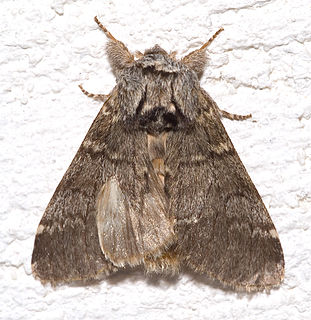Related Research Articles

Mythimna impura, the smoky wainscot, is a moth of the family Noctuidae. The species was first described by Jacob Hübner in 1808. It is distributed throughout most of the Palearctic realm from Ireland in the west of Europe east to the Caucasus, Turkey, Syria, Kazakhstan, Russia, Siberia, Mongolia, then Japan. In Europe it is found from the Arctic Circle to Spain and Italy in the south, as well as in the northern regions of Greece.

Drymonia ruficornis, the lunar marbled brown, is a moth of the family Notodontidae. It is found in Central and Southern Europe and Anatolia.

The Essex y is a moth of the family Noctuidae. It is found from Italy to Greece, southeastern Europe, southwestern Russia, the southern parts of the Ural, Africa, Canary Islands, Arabia, southwestern Asia, Ceylon, from India to Nepal, southeastern China and Japan.

Lygephila craccae, the scarce blackneck, is a moth of the family Erebidae. It is found in temperate Europe and across the Palearctic to the Altai Mountains, Korea, Japan and China.

Hadula melanopa, the broad-bordered white underwing, is a moth of the family Noctuidae. The species was first described by Carl Peter Thunberg in 1791. Subspecies H. m. melanopa is found in northern Scandinavia; subspecies H. m. rupestralis is found in the Alps, the Balkan Mountains and the Apennine Mountains; subspecies H. m. brunnea is found in mountainous areas of Great Britain and subspecies H. m. koizumidakeana is found in Japan.

Apamea furva, the confused, is a moth of the family Noctuidae. The species was first described by Michael Denis and Ignaz Schiffermüller in 1775. It is found throughout Europe. In southwestern Europe it is primarily montane. It is found as far north as the Arctic Circle. From Europe its range extends to Siberia, Turkey, Iran, Kyrgyzstan, Mongolia and Xinjiang in China.
Cacozophera is a monotypic snout moth genus described by Harrison Gray Dyar Jr. in 1919. It contains the species Cacozophera venosa described by the same author. It is found in Guatemala.
Apomyelois decolor, the Caribbean dried fruit moth, is a species of snout moth in the genus Apomyelois. It was described by Philipp Christoph Zeller in 1881. It is found in France, Florida, the Antilles, Central America and South America.
Australephestiodes is a genus of moths belonging to the family Pyralidae. It contains only one species Australephestiodes stictella, which is found in Florida and on the Bahamas, Jamaica, Puerto Rico and the Virgin Islands.
Baphala goyensis is a species of snout moth in the genus Baphala. It was described by Ragonot in 1901, and is found in south-eastern Brazil, Uruguay and Argentina.
Vitula pinei is a species of snout moth in the genus Vitula. It was described by Carl Heinrich in 1956. It is found in the US states of California, Arizona, Texas and Utah.
Nevacolima jaliscoensis is a species of snout moth in the genus Nevacolima. It is found in west-central Mexico.
Syllepte birdalis is a moth in the family Crambidae. It was described by William Schaus in 1920. It is found in Venezuela.
Ceranemota amplifascia is a moth in the family Drepanidae. It was described by John Frederick Gates Clarke in 1938. It is found in North America, where it has been recorded from California.
Machimia dolopis is a moth in the family Depressariidae. It was described by Walsingham in 1912. It is found in Mexico (Guerrero).
Inga erythema is a moth in the family Oecophoridae. It was described by Walsingham in 1912. It is found in Guyana, Brazil and Central America.
Ebbepterote is a monotypic moth genus in the family Eupterotidae. It was erected by Rolf G. Oberprieler, Wolfgang A. Nässig and Edward David Edwards in 2003. Its only species, Ebbepterote expansa, was described by Thomas Pennington Lucas in 1891. It is found in Australia, where it has been recorded from Queensland.
Chionodes cerussata is a moth in the family Gelechiidae. It is found in Mexico.
Aroga websteri is a moth of the family Gelechiidae. It is found in North America, where it has been recorded from Washington.
Cryptophasa phycidoides is a moth in the family Xyloryctidae. It was described by Thomas Pennington Lucas in 1901. It is found in Australia, where it has been recorded from New South Wales and Queensland.
References
- ↑ "GlobIZ search". Global Information System on Pyraloidea. Retrieved 2014-07-15.
- ↑ Proceedings of the United States National Museum 120 (3561)
| This Loxostege article is a stub. You can help Wikipedia by expanding it. |